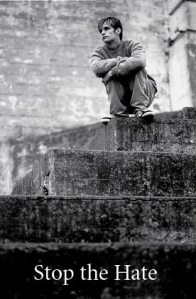On June 3, as word spread that hundreds of thousands of troops were approaching from all four corners of the city, citizens of Beijing, China, flooded the streets to block them, as they had done two weeks earlier. People set up barricades at every major intersection. At about 10:30 p.m., near the Muxidi apartment buildings — home to high-level Party officials and their families — the citizens became aggressive as the army tried to break through their barricades. They yelled at the soldiers and some threw rocks; someone set a bus on fire. The soldiers began firing on the unarmed civilians with AK-47s loaded with battlefield ammunition. Human rights observer Timothy Brook recalled:
The first rounds of fire catch everybody by surprise. The people in the streets don’t expect this to happen. There are a couple of hospitals right near Muxidi, and the casualties start showing up within 10 or 15 minutes of the first round of gunfire. The casualties run very high because people didn’t expect to be shot at with live ammunition. When they start firing, people say, “Oh, it’s rubber bullets.” Even after it becomes clear, even after they realize that the army is going to go ahead at any cost, people still pour into the streets. This is the amazing thing: People were just so angry, so furious at what was happening in their city that they were not going to step back and let the army do what it was doing. This is why the casualties from Muxidi on east towards Tiananmen Square were so high. This is the major military confrontation of the evening.
__________________________________________________
__________________________________________________
The attack continued into the early morning hours of June 4. The wounded were taken to nearby hospitals on bicycles and pull-carts, but the hospital staff were unequipped to deal with the severe wounds. Muxidi saw the highest casualties of the night; an untold number of people were killed. Reporters and Western diplomats on the scene estimated that at least 300, and perhaps thousands, of the protesters had been killed and as many as 10,000 were arrested. You can see more historic photographs by clicking here and here.
On the night of June 3, Liao Yiwu was home in the southwestern Chinese province of Sichuan. The news of the brutal suppression of the students’ pro-democracy movement shocked him to the very core. Overnight, Liao composed a long poem, “Massacre,” which portrayed, with stark imagery, the killing of innocent students and residents as vividly as Picasso depicted the Nazi massacre in the town of Guernica.
Without any chance of having his poem published in China, Liao made an audiotape of himself reciting “Massacre,” using Chinese ritualistic chanting and howling to invoke the spirit of the dead. The tape recording was widely circulated via underground channels in China.
Excerpt from “Massacre”
By Liao Yiwu
(translated by Wen Huang)
Dedicated to those who were killed on June 4, 1989
A massacre is happening
In this nation of Utopia
Where the Prime Minister catches a cold
The masses have to sneeze to follow
Martial law is declared and enforced
The aging toothless state machine is rolling over
Those who dare to resist and refuse to sneeze
Fallen by the thousands are the barehanded and unarmed
Armored assassins are swimming in blood
Setting fire to houses with windows and doors locked
Polish your military boots with the skirt of a slain girl
Boot owners don’t even tremble
Robots without hearts never tremble
Their brain is programmed with one process
A flawed command
Represent the nation to dismember the constitution
Represent the constitution to slaughter justice
Represent the mothers to suffocate the children
Represent children to sodomize the fathers
Represent the wives to murder the husbands
Represent the citizens to bomb the city
Open fire, open fire, open fire
Shoot women, students and children
Shoot workers, teachers and venders
Riddle them with bullets
Aiming at those angry faces, shocking faces, contorted faces, despondent faces and tranquil faces
Shoot with abandon
The fleeting beauty of those faces moving toward you like tidal waves
The eternal beauty of those faces heading toward heaven and hell
The beauty of turning humans into beasts
The beauty of seducing, raping and trampling on your fellow citizens
Eliminate beauty
Wipe out the flowers, forest, school campuses, love, and the pure air
Shoot, shoot and shoot…
I feel good and I feel high
Blow up that head
Burn up the hair and the skin
Let the brain erupt
Let the soul gush out
Splash on the bridge, the fence and the street
Splash toward the sky
Blood turned into stars and stars are running
Heaven and earth have turned upside down
Shiny helmets are like stars
Troops are running out of the moon
Shoot, Shoot, Shoot
Humans and stars are falling and running
Indistinguishable, which are humans and which are stars
Troops followed them into the cloud, into cracks on the ground …We live under bright sunlight
But we have lost our eyesight
We find ourselves on a street, so wide
But no one can take a stride
We stand in a crowd, supposed to be loud
But people open their mouth without sound
We are tortured with thirst
But everyone refuses water.This unprecedented massacre
Survivors are those bastards.
The savagery of the Chinese government’s attack shocked both its allies and Cold War enemies. Soviet leader Mikhail Gorbachev declared that he was saddened by the events in China. He said he hoped that the government would adopt his own domestic reform program and begin to democratize the Chinese political system. In the United States, editorialists and members of Congress denounced the Tiananmen Square crackdown and pressed for President Bush the First to punish the Chinese government. A little more than three weeks later, the U.S. Congress voted to impose economic sanctions against the People’s Republic of China in response to the brutal violation of human rights.

4 am, 4 June 1989, Tiananmen Square. Soldiers rushed out of the Great Hall of the People, with guns pointed towards students under the Hero's Memorial. They fired as they pushed forward. In this picture the flash out of the muzzle of one soldier's weapon is clearly visible. Professor Ding Zilin collected two more names of students who perished that night in the Tiananmen Square.
Obstinately, the People’s Republic of China continues to deny the facts. “There were no deaths in the square,” according to a deceptive article that was published in the People’s Daily on September 19, 1989.
James Miles — who was the BBC’s Beijing correspondent at the time of the Tiananmen Square events — wrote an article dated 2 June 2009 entitled “Tiananmen killings: Were the media right?“, noting that:
We got the story generally right, but on one detail I and others conveyed the wrong impression. There was no massacre on Tiananmen Square.
(. . .)
Evidence of a massacre having occurred in Beijing was incontrovertible. Numerous foreign journalists saw it from widely scattered vantage points.
On the morning of 4 June, reporters in the Beijing Hotel close to the square saw troops open fire indiscriminately at unarmed citizens on Chang’an Boulevard who were too far away from the soldiers to pose any real threat. Thirty or 40 bodies lay, apparently lifeless, on the road afterwards. That scene outside the Beijing Hotel alone justified the use of the word massacre. But the students who had told me and other journalists of a bloodbath on the square proved mistaken.
Protesters who were still in the square when the army reached it were allowed to leave after negotiations with martial law troops (Only a handful of journalists were on hand to witness this moment – I, like most others at the time, had spent the night in various different parts of the city monitoring the army’s bloody advance). A few of the students were crushed by armoured vehicles some distance from the square after the retreat. There were credible reports of several citizens being shot dead during the night on the outer perimeter of the square, but in places which strictly speaking could be said to be outside the square itself. But we are far less certain of killings on Tiananmen proper. There were probably few, if any.
(. . .)
The Chinese government was quick to exploit the weaknesses in our reporting. By focusing on what happened in the square itself, it began sowing seeds of doubt about the general accuracy of Western reports among Chinese who did not witness what happened. At first this made little difference, since most Beijing residents at least had friends of friends who had seen for themselves that there had been a massacre, even if not in the square. But as the years passed, a new generation emerged with few eyewitness accounts to cling to.
(. . .)
[Today, it] is not uncommon to find Chinese who believe the Communist Party’s fiction that there was a riot in Beijing on 3 June that warranted intervention. Rioting did occur, but involving angry residents outraged by the army’s brutal entry into the city.
(. . .)
There was no Tiananmen Square massacre, but there was a Beijing massacre. [emphasis added]
___________________________________________________
Hu Ping explains the implications of June 4th, 1989 for the world:
___________________________________________________
Suggested reading:
- Tiananmen Papers– Andrew Nathan and Perry Link
- Mandate of Heaven– Orville Schell
- Almost a Revolution– Shen Tong
- Disco’s and Democracy– Orville Schell
- Moving the Mountain– Li Lu
- Black hands of Beijing– George Black Robin Munro
- Children of the Dragon– Human Rights in China
- Bring down the Great Wall – Fang Lizhi
- The Power of Tiananmen– Dingxin Zhou
- Beijing Spring– David and Peter Turnley
- Prisoner of the State– Zhao Ziyang
- Quelling the People– Timothy Brook
- Escape from China– Zhang Boli
- A glossy propaganda book published by the Chinese Government called The Truth about the Beijing Turmoil
Videos about Tiananmen Square:
- The Gate of Heavenly Peace – documentary
- Moving the Mountain– Movie
- Tank Man– PBS documentary
- Democracy Crushed, Tiananmen Square– The History Channel
- Tiananmen Declassified– The History Channel































You must be logged in to post a comment.